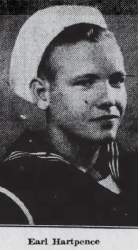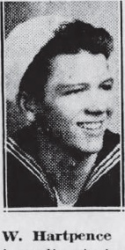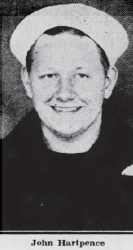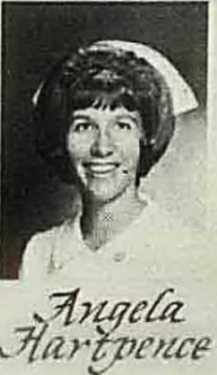
 |
|
|
||
|
EARL NIXON HARTPENCE |
||||
|
Engagements: • World War II (1941 - 1945) |
||||
| Biography: | ||||
|
Earl was the son of Whitfield Thatcher and Hannah Lear Hartpence who were married about 1918. His siblings were ; Raymond C., John Carter, Whitfield Thatcher Jr., and Thomas C. Hartpence. John Carter and Whitfield Thatcher Carter also served in WWII. Earl attended Lambertville High School in Lambertville, NJ before he enlisted in the US Navy (NSN: 223-84-14) as an Apprentice Seaman on 17 Sep 1940 in New York, NY. He was sent to the Naval Training Station (NTS) Newport, RI for recruit training. Upon completion of recruit training and a short leave period, AS Hartpence reported to the light cruiser, USS Philadelphia (CL-41), for duty on 16 Nov 1940. On 17 Jan 1941, AS Hartpence was promoted to Seaman Second Class (S2/c). Three months later on 20 April 1941, S2/c Hartpence was transferred to the Asiatic Fleet via the USS Henderson (AP-1). He reported aboard the Henderson on 23 Apr 1941 as a passenger bound for Manila, Philippines. The Henderson got underway that day from the navy yard at Pearl Harbor. She steamed westward with stops at Midway and Wake Islands before steaming to Guam and finally reaching Manila on 15 May 1941. She disembarked her cargo and passengers including S2c Hartpence. He was then transferred to the heavy cruiser, USS Houston (CA-30), for further transfer (FFT) to the destroyer tender USS Black Hawk (AD-9) at anchor in Shanghai, China. On 25 May, Hartpence reported on board the Black Hawk and reported in to ComDesRon 29 who assigned him to duty with USS Edsall (DD-219). The next day, S2c Hartpence reported on board the Edsall for duty. The threat of hostilities between the United States and Japan grew closer to the boiling point as the year 1941 began. Admiral Hart, Asiatic Fleet CINC, determined it was time to send all of the families of his sailors home. There was push-back from the resentful spouses who initially declined to leave their husbands. It was only a threat to indefinitely restrict their spouses to their ships without leave that finally convinced the families; it was time to comply with orders and return to the continental United States (CONUS). Admiral Hart's directive probably saved many family members from internment by the Japanese or worse. For many of the married sailors, it was the last time they would ever see their families. Then, in July 1941, as Japanese aggression intensified with their move south into lower Indo-China, Admiral Hart warned his officers that he had no doubt that war would come although he didn’t know how or when it would start. Hart trained his destroyer crews hard keeping them on a war-footing for extended periods and away from Cavite naval base as much as possible exercising his “defensive deployment.” Ordered to comply with Adm. Hart’s “defensive deployment” well south of Manila, units of the Asiatic Fleet, including destroyer tender USS Blackhawk (AD-9), USS Edsall (DD-219) and other ships of Destroyer Division (DesDiv) 57, got underway on 25 Nov 1941, and arrived on the morning of 29 Nov 1941 in Balikpapan, a major oil port on the eastern coast of Borneo. On 8 Dec 1941, Edsall, an element of Destroyer Division 57 (DESDIV), was enroute to Batavia (Djakarta) when word of the attacks on Pearl Harbor was received. The division altered course to Singapore to act as ASW screen for Force Z. From Singapore, Edsall was sent to search for survivors of HMS Prince of Wales and HMS Repulse, sunk off Malaya on 10 Dec. No survivors were found. It was learned later that other ships had retrieved the survivors. For the next month, Edsall and other units of DESDIV 57 were used to escort shipping to and from Australia. It was on one of these escort trips that Edsall participated in the sinking of IJN submarine (I-124) off Darwin. Several days later, Edsall was damaged during another attack on a suspected submarine. One of Edsall's depth charges exploded prematurely in shallow water damaging one of Edsall’s propeller shafts. This damage would play an important role in her eventual sinking about a week later. On 3 February, Edsall and other American units of the American-British-Dutch-Australian Force (ABDA) moved up to Tjilatjap, Java in order to be closer to the combat theater and refueling facilities. She continued her service as a patrol vessel off southern Java. On 26 February, she steamed from Tjilatjap with her sister ship USS Whipple (DD-217) to rendezvous with the converted seaplane tender USS Langley (AV-3) carrying P-40E fighters and crews for the defense of Java. On 27 February, the Langley, along with Edsall and Whipple, came under attack by sixteen (16) Mitsubishi G4M "Betty" bombers of the Japanese 21st and 23rd Naval Air Flotillas and escorted by fifteen (15) A6M Reisen fighters. The attack fatally damaged Langley. She had to be abandoned and later scuttled by Whipple. Edsall rescued 177 survivors; Whipple, 308. On 28 February, the two destroyers rendezvoused with the fuel replenishment ship USS Pecos (AO-6) off Flying Fish Cove, Christmas Island some 250 miles southwest of Tjilatjap. A sudden attack by land based Japanese bombers forced Edsall and the other ships to head for the open sea. They headed directly south into the Indian Ocean for the rest of 28 February in high winds and heavy seas. Early in the pre-dawn hours of 1 March, Whipple and Edsall transferred all the Langley survivors to Pecos. There were now close to 700 personnel on board the ship. Whipple then set off for Cocos Islands as protection for the tanker Belita sent to meet her there. The Pecos, carrying a large number of survivors was ordered to Australia. Edsall had retained 32 USAAF personnel from Langley needed to assemble and fly an additional 27 P-40E fighters shipped to Tjilatjap aboard the transport Sea Witch. Edsall was instructed to return these "fighter crews" to Tjilatjap. At 0830, she reversed course and headed back to the northeast for Java. At noon that day, planes from Japanese aircraft carrier Soryu attacked Pecos and struck again an hour later. Finally, in mid-afternoon, third and fourth strikes from aircraft carriers Hiryu and Akagi fatally wounded the Pecos. While under attack, Pecos radioed for help. After Pecos sank, Whipple returned to the scene intentionally arriving after dark. She eventually rescued 232 survivors. Many other survivors, although visible to crewmembers on board Whipple, had to be abandoned at sea because Whipple made sonar contact with what was believed to be several Japanese submarines. It was just too dangerous for her to remain in the area. Edsall may have heard Pecos’s call for help or she may have been complying with orders to reverse course and steam toward Australia. For whatever the reason, Edsall reversed course and was never heard from again. The US Navy Department simply said Edsall was lost due to enemy action. The US Navy Department declared all Edsall crewmembers “presumed dead” on 25 Nov 1945. This finding of presumptive death date was fixed in order to take care of settlements and claims. At that point no one suspected that survivors from Edsall were among many victims of war crimes on Celebes. Because no known survivors lived to tell the story, the details surrounding the sinking of Edsall remained largely a mystery for more than a half century. Finally, after historians compiled bits and pieces of information from various allied sources over the years, Japanese records and eyewitnesses on the Chikuma recently became available. The new information points to a short but epic battle involving the aging Edsall and one of the world's strongest naval forces of its day. After Edsall reversed her course on 01 Mar 1942 and steamed away from Java, she stumbled upon Admiral Nagumo's battle force, Kido Butai, that had been prowling the Indian Ocean in search of enemy shipping. Unfortunately, Edsall was spotted first. She was misidentified as a light cruiser of the Marblehead class. IJN battleships Hiei and Kirishima and heavy cruisers Tone and Chikuma were detached from the battle force to attack Edsall with surface gunfire. The old four-stacker began evasive maneuvers frustrating the Japanese for the next hour and half. However, because of the damage done previously to one of her propeller shafts, Edsall was unable to make top speed or maneuver fully. At one point Edsall turned and launched her torpedoes narrowly missing Chikuma. The Japanese fired some 1400 rounds resulting in only one or two direct hits. The frustrated Admiral Nagumo called upon his carriers to finish off the Edsall. She was attacked by dive-bombers from two Japanese carriers (Kaga, Soryu,) and possibly a third (Hiryu) before succumbing to this devastating attack. The Edsall went down at 1900 hours, 01 Mar 1942, 430 miles south of Java. Japanese eyewitnesses confirm that at least eight Edsall crewman from a large number of survivors were fished out of the water and brought on board the Chikuma. The rest of the survivors were left to their fate in the water. Chikuma and the rest of the battle force arrived at Staring Bay anchorage, Celebes on 11 Mar 1942. Three dozen POWs, 8 or more from the Edsall and the remainder from a Dutch ship, were turned over to the Japanese Special Naval Landing Forces based at Kendari where they were executed on 24 Mar 1942 near Kendari II airfield. After WWII ended, an Allied War Crimes Tribunal was convened in Java. During the course of the Tribunal's investigations, an eyewitness to Japanese executions was discovered and interviewed. He testified that he witnessed the execution by the Japanese of a number of POWs in 1942. He led investigators to the Japanese Execution Grounds mass grave, Kendari II, Celebes, N.E.I. *Five sets of remains in a group of about 10 were later identified from ID tags as USS Edsall crewmen. The other five were unknown but were possibly US Army Air force personnel on board Edsall from the Langley. A sixth set of remains were found in another burying ground on Celebes. They were identified by an ID tag as those of Fireman Second Class (F2) Loren Stanford Myers, a crewman from the Edsall. All of these remains were disinterred and reburied in the US Military Cemetery, Barrackpore, India on 12 Nov 1946. After three years, their remains were disinterred again and reburied in a mass grave at the National cemetery at Jefferson Barracks, St. Louis, MO on 20 Dec 1949. The remains of F2 Myers were reinterred according to immediate family wishes in the National Memorial Cemetery of the Pacific in Honolulu, HI on 31 Mar 1950. With the discovery of these remains, their presumed date of death was amended to 02 Mar 1942. Hartpence was declared missing in action on 01 Mar 1942. He was declared "presumed dead" on 25 Nov 1945. His remains were unrecoverable. S2c Hartpence was awarded (posthumously) the Purple Heart, American Defense Service Medal with Fleet Clasp, Asiatic-Pacific Campaign Medal with two bronze stars, Philippine Defense Medal, World War II Victory Medal, and he was eligible for the Combat Action Ribbon (created in 1969 retroactive 07 Dec 1941). ------------------------------- A commemoration in honor of S2c Hartpence's service from President Harry S. Truman reads: In Grateful Memory of Earl Nixon Hartpence, Who Died In The Service Of His Country At Sea, Asiatic Area, attached U.S.S. Edsall, 25 November 1945 (presumed). He stands in the unbroken line of patriots who have dared to die that freedom might live, and grow, and increase its blessings. Freedom lives, and through it, he lives – in a way that humbles the undertakings of most men. Signed, Harry Truman President of the United States of America ------------------------ The Courier-News (Bridgewater, NJ) - 31 Mar 1942, Tue - p.1 Earl Hartpence of Plainfield Killed During Fight Off Java Another Plainfield youth has given his life for his country, it was learned today. Mrs John DeVico announced the Navy Department had informed her that her son, Earl Nixon Hartpence, 20 years old, had been "lost in action." Although details were lacking in the telegram, it was believed the youth was serving on a destroyer which participated in sea battles in the vicinity of Java. Hartpence enlisted in the Navy Oct 17, 1940 (sic). He was born in New Hope, PA, where he spent his early childhood. He later resided with his parents in Rocktown, Pleasant Valley and Lambertville, N.J. He attended Lambertville High School before entering the Navy. His mother and brothers moved to Plainfield after he enlisted, but he had visited his family here during one or two furloughs before his ship was sent to Asiatic waters. The last word Mrs. DeVico received from her son was a Christmas card which arrived in Plainfield Mar. 2. The card was post marked "Cavite, P.I." Mrs DeVico has another son in the Navy, His is John Hartpence, 21 years old, who enlisted Mar. 6. He is now stationed at the Newport, R.I. training station. "He will get revenge for his brother," was Mrs. DeVico's only comment. There are also two other brothers, Whitfield Hartpence, residing at home; and Thomas Hartpence, living with an aunt, Mrs Mary Hann, in Lambertville. [original article edited for content.] -------------------------------- Bio #12 composed by Gerry Lawton (G47, GML470) Find A Grave memorial page #56788615 |
||||
| Honoree ID: 140917 | Created by: MHOH | |||
Ribbons
Medals
Badges
Honoree Photos
 |  |  |
 |  |
 |


